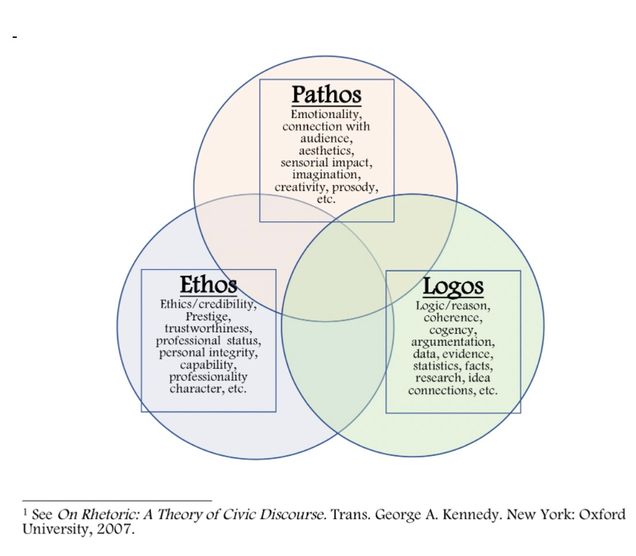Though all sections of WR 111 ask students to write and revise a rhetorical analysis of a passage from a course text, instructors have their own preferred ways of introducing this assignment. You may decide whether you wish to refer to Aristotelian models or not; this page gives you two possible approaches to this assignment. Note that instructors might want to suggest specific texts, or even passages, for students to choose among to analyze, rather than leaving the choice entirely open, just so students are choosing fruitful texts for this assignment.
Objective
to practice evaluating rhetorical techniques; to move past identifying techniques into discussing the effects of a writer’s rhetorical techniques; (optional) to explore how these passages are effective using Aristotle’s model of rhetorical appeals: ethos, pathos and logos, or ethics/credibility, emotion and reason/logic
Key Terms
analysis; rhetorical techniques
Option 1: Standard “close-reading” rhetorical analysis of diction and style
- Make a copy of the passage you’ll be analyzing so that you can annotate it; you will be turning this in with your work. On this copy actively mark the text with any highlighting, questions, comments you have as you read.
- Identify any of the rhetorical techniques you discover in a short, 1-3 paragraph passage from one of our readings. These may include:
- parallelism
- repetition
- metaphor or simile
- symbolism
- definition
- tense shifts
- rhetorical questions
- tone shifts
- varying sentence structure and/or length
- dialect or non-standard usage
- Prepare a 1-1/2 page reflection on the rhetorical techniques you find in the passage.
- Identify the technique(s) you have discovered and discuss their effect.
- Think more, as you plan your response, about the following aspects of the author’s diction, and take notes:
- How does the rhetorical technique contribute to the tone of the essay?
- What message is conveyed by the write’s choice of words/structures?
- Does the device draw readers into the passage or push them away?
- Does it slow down or speed up the reading?
- Does the technique provide emphasis?
- Does it make the passage more persuasive?
- Try substituting other words/phrases in the sentence. Which one requires you to change the sentence structure?
- Does the voice or attitude of the original sentence change when you substitute these alternate words/phrases? If so, why?
- How would the passage feel different to a reader if the author had phrased things differently?
- When and why might these phrases or techniques be used in your own writing?
- Decide, once you have identified the rhetorical techniques and started thinking closely about their effects, how to organize the supporting material. The following strategies will be involved in the process:
Integrating Sources: These are the steps to follow when you refer to specific parts of the text:
- Underline key words or phrases;
- Decide whether you want to summarize, paraphrase, or quote;
- Introduce the specific segment with an effective verb and integrate the summary, paraphrase, or quotation into your sentence;
- After the citation, put the page number in parentheses, before the end of-clause punctuation.
Quotation: In academic writing, you are usually balancing your voice with the ideas and research of other people. When you decide to incorporate quotations from experts into your own writing follow these guidelines:
- Keep exceptionally memorable passages;
- Strengthen arguments by referring to acknowledged authorities in the topic;
- Capture the flavor of the original diction.
Option 2: Aristotelian rhetorical analysis
- Make a copy of the passage you’ll be analyzing so that you can annotate it; you will be turning this in with your work. On this copy actively mark the text with any highlighting, questions, comments you have as you read.
- Identify and analyze two rhetorical techniques in a passage from one of our readings. Your passage should be a paragraph or a short chain of closely related sequential paragraphs that make a certain point.
- Structure your analysis using the following model
-
- Paragraph 1: Introduction
Here you should introduce the author, title, and a short summary of the main idea of the text. You should focus on the author’s main idea and purpose for writing in your summary and briefly introduce the two rhetorical devices you have chosen and how you would summarize their contributions to the effectiveness of the text.
- Paragraph 1: Introduction

-
- Paragraph 2: Analysis of Rhetorical Technique #1
Your paragraph should start with a topic sentence that introduces the rhetorical technique, citing the rhetorical element from your passage. If you choose a technique where the exact wording matters (parallelism, metaphor, simile, repetition, definition, rhetorical questions, varying sentence structure/length, or nonstandard use of language), you should use a direct quote. If you choose a technique where the exact wording is less important (extended metaphor, symbolism, tense shifts, tone shifts, or examples), then you should use a paraphrase. Offer an explanation of the rhetorical technique and how it contributes to the communicative purposes of the text by specifically referencing Aristotle’s model for rhetorical appeals and how it works in conjunction with other contextual factors. Remember that a rhetorical device can make more than one appeal at the same time. In fact, try to explore those areas of writing that integrate all three of Aristotle’s pistes at the same time. These are, typically, the most effective and persuasive.
- Paragraph 2: Analysis of Rhetorical Technique #1
-
- Paragraph 3: Analysis of Rhetorical Technique #2
Repeat the process of Paragraph 2 for your second rhetorical technique.
- Paragraph 3: Analysis of Rhetorical Technique #2
-
- Paragraph 4: Reflection
Think about what you can learn from your chosen author’s use of rhetorical techniques as a writer yourself. Write one paragraph reflecting on your own use of the rhetorical sensibilities you have analyzed in the text and how you think they can improve your own writing: Have you used either of these techniques in the past? When might you use some of these techniques in your future writing?
- Paragraph 4: Reflection
